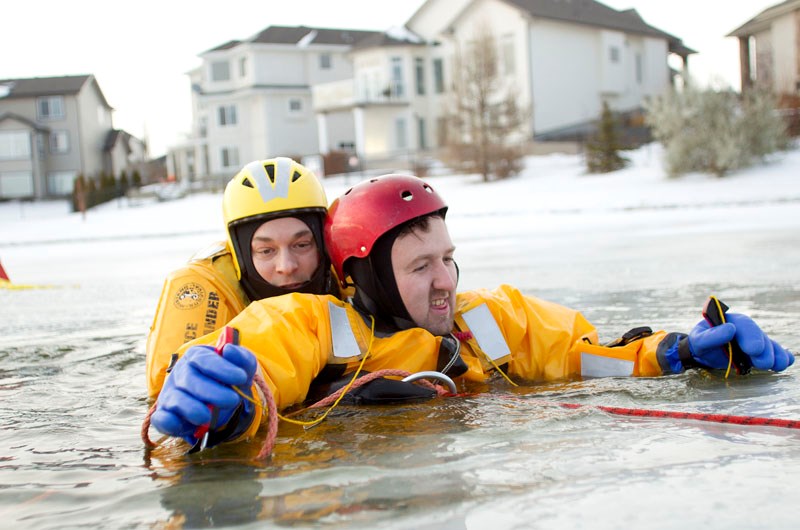The biggest surprise about jumping into a pond in late November was how cold I wasn't.
Despite repeated assurances, I was not supremely confident the survival suit the St. Albert Fire Department outfitted me with would keep me warm during their twice-annual exercise in ice-water rescue this week. When I slid into the water, I expected to instantly regret agreeing to this exercise in first-person journalism.
Lieut. Jeff Austin with the department said many firefighters are also initially sceptical the suit will protect them, which is why it is important to do the training.
"The more confident we are in our equipment the better off we are."
As water splashed up on my face, it was clear it was the suit keeping me warm and the water was every bit as cold as I feared.
The survival suit the department uses costs about $1,000 and goes on like a child's snowsuit, in one big piece with the boots and gloves permanently attached.
Austin said the department aims to leave the hall within 90 seconds of receiving a call, including one for an ice-water rescue. Well into my fifth or sixth minute of getting the suit on I realized anyone hoping for my rescue in an emergency would be in serious danger.
The suit has an inner liner designed to keep the wearer warm and buoyant and an outer liner designed to keep the water out. The two-piece system means that if the outer liner rips, a distinct possibility in a real rescue with jagged ice, the suit would still be relatively warm and more importantly buoyant.
When I slid in the water, I immediately swelled up like the Michelin man and even keeping my feet below the water was difficult. Austin said the firefighters combat the buoyancy by wearing ankle weights, which under normal circumstances would drag them straight to the bottom.
To be able to move in the suit, I grabbed at my collar, pulling it away from my neck. The air rushed out past my face and it felt like standing on a platform when a train comes in. Below the water the suit tightened around me as the air rushed out, as though I was being vacuum-packed.
For the rescue, a firefighter came in from behind and wrapped a rope strapped to him around my torso, just under my arms. When the firefighters on the shore started to pull, I was pulled up and out of the water.
Austin said in a real emergency the fire department tries to avoid getting in the water, if they don't have to.
"We don't ever want to lose a rescuer to become a victim."
He said getting in the water is a last resort, but they will do it if it means saving a life.
"Going in the water with a person who has fallen in is very dangerous. It is the most dangerous thing you can do, but if it is going to possibly save a life we are going to do it."
He said a lot of the danger in getting into the water is from the victim being rescued. They often understandably panic and can latch onto or grab at the firefighter, making the situation worse.
"If somebody is panicking in the water when we get in we are going to calm them down first."
He said that is also why the rescuer comes in from behind the victim.
Getting out
Austin's advice for people who fall in the water is to try and get out of the water by themselves if they can. To do that he advises pulling up, shuffling along on your elbows.
"Use your elbow, not your hands and try not to push up. As soon as you push up, the ice is going to break again."
He said if you can't get out, try to remain calm, call for help and attract someone's attention. He also said if you stick to the ledge, your clothing may freeze to the ice, which will help you stay above water.
"The biggest thing is not to panic. The more energy you expend the quicker you will succumb to the cold."
Austin said the department hasn't had to use this training in real-life situations very often. When they have, it has often been to save dogs or other pets. While they won't risk a firefighter's life to save a dog, they try to save the animal because if they don't, the owner will try, and they end up saving the owner.
Despite the rarity of the emergency, he said it is important to train for the possibility.
"St. Albert is a city that promotes activity on our lakes, the man-made lakes, so it is always a risk factor that we have," he said. "We have to be prepared for all possibilities."




